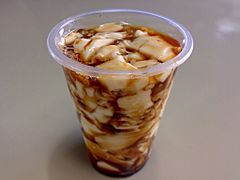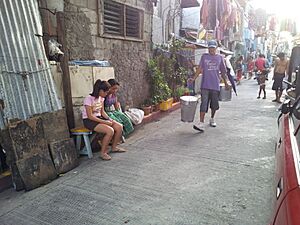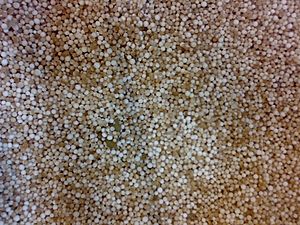Taho facts for kids

A cup of tahô
|
|
| Course | Dessert, snack |
|---|---|
| Place of origin | Philippines |
| Serving temperature | Warm or room temperature |
| Main ingredients | Silken tofu, arnibal (brown sugar syrup), sago pearls |
| 323 kcal (1352 kJ) | |
| Similar dishes | douhua |

Tahô is a popular Filipino snack. It's a sweet and warm treat made from three main parts:
- Soft, silky tofu (like a very smooth custard).
- Arnibal, which is a sweet syrup, usually made from brown sugar.
- Small, chewy sago pearls, similar to tapioca pearls.
You can find tahô sold by friendly vendors all over the Philippines. It's a favorite comfort food for many!
Contents
The History of Tahô
Tahô has a long history! It came to the Philippines from China. People from a Chinese group called the Hokkien people brought it over. They had a similar dish called douhua. Over time, it became the delicious tahô we know today in the Philippines.
How Tahô Is Made
Making tahô involves preparing its three main parts. Most tahô vendors start preparing these ingredients very early in the morning.
Making the Tofu Base
The main part is the fresh, soft tofu. It's made to be super smooth, almost like a fine custard. This soft tofu is the base of the tahô.
Creating the Sweet Arnibal Syrup
Next is the arnibal syrup. This is made by cooking brown sugar until it turns into a rich, golden-brown caramel. Then, water is added to make a thick, sweet syrup. Sometimes, a little vanilla is added for extra flavor.
Preparing the Sago Pearls
The tiny sago pearls are boiled until they become soft and chewy. They turn a clear, see-through white color when they are ready. These pearls add a fun texture to the tahô.
Selling Tahô
You'll often see a mágtatahô (that's what a tahô vendor is called) walking through neighborhoods. They carry two big aluminum buckets on a carrying pole across their shoulders.
The Vendor's Tools
The bigger bucket holds the warm, soft tofu. The smaller bucket has the sweet arnibal syrup, the sago pearls, and a small box for money.
Calling Out to Customers
Mágtatahô vendors have a special way of selling their tahô. They walk slowly and call out "Tahô!" in a loud, rising voice. This helps people know they are nearby. They usually come by in the early morning, but you might also find them in the afternoon or evening.
Serving the Tahô
Most vendors carry plastic cups and spoons. Sometimes, customers use their own cups. The vendor uses a wide, shallow scoop to get the soft tofu into the cup. They carefully remove any extra water. Then, they use a small ladle to add the sago pearls and the sweet arnibal syrup. They mix it all together gently.
How to Enjoy Tahô
Tahô is usually served warm, which makes it a perfect comfort food. You can eat it with a spoon, sip it with a straw, or just slurp it straight from the cup.
Sometimes, you can find cold tahô in stores or cafes. These often come in pre-packed cups with firmer tofu.
Different Kinds of Tahô
While the classic tahô with brown sugar syrup is most common, there are other fun varieties!
Strawberry Tahô
In Baguio, a city known for its strawberries, you can find strawberry tahô. Instead of brown sugar syrup, they use sweet strawberry syrup!
Other Flavors
Some other kinds of tahô use different syrups, like white cane sugar syrup or even chocolate sauce.
Images for kids
-
A mágtatahô walking through a residential area in Manila.
See also
 In Spanish: Tajú para niños
In Spanish: Tajú para niños





